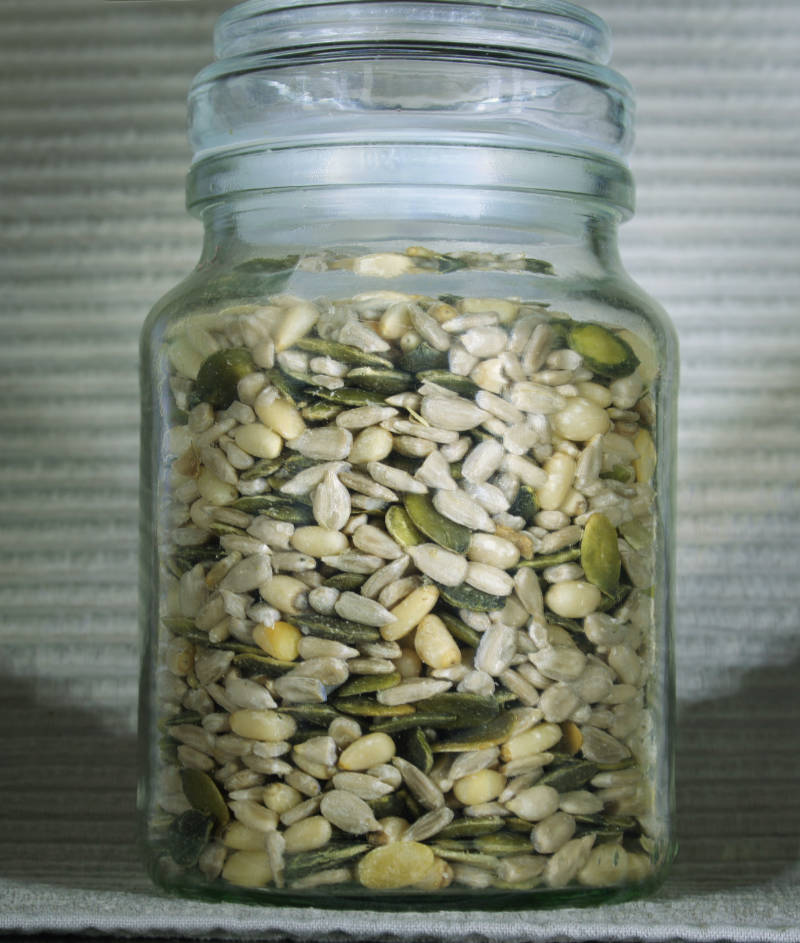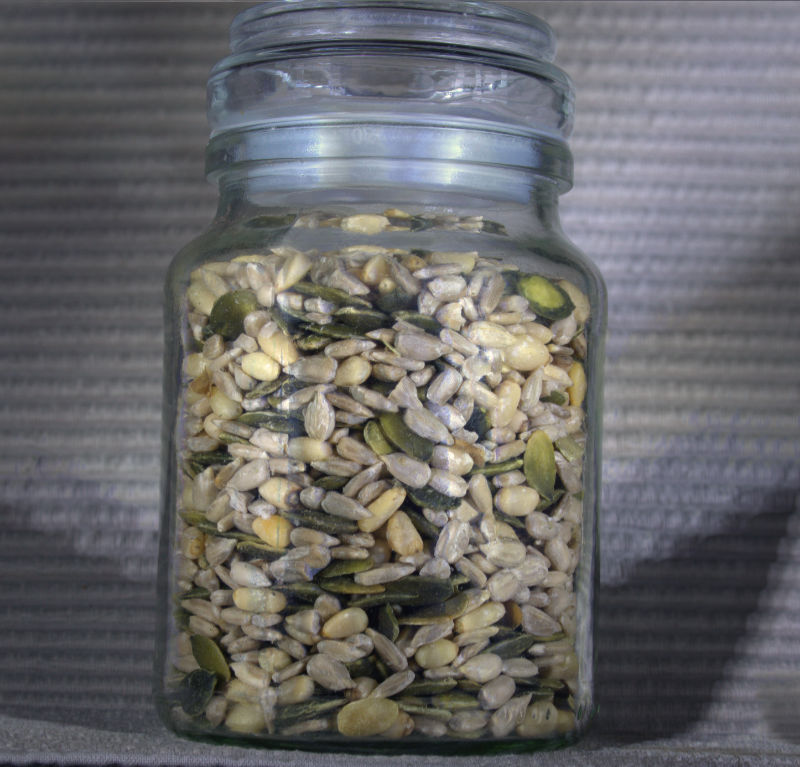The aim here is to merge several images which have lighting from different directions. My eventual aim for photographing fungi using a single LED bar as the source. For my trial I used a glass jar filled with seeds (my breakfast). The LED light was placed vertically, firstly at 90degrees, then about 60 and 40 on the left, then on the right (siz altogether). Each of these had a strong specular reflection at some point, but these reflections did not overlap. I first tried merging them in HDR, but this still gave strong specular highlights.
I then discovered the technique of median merging in Photoshop. THis involves loading the images into a stack, converting to a Smart Object and selecting the median merge option.
Having obtained Affinity Photo, I find it can do the same thing, only much more simply. Load the images into a stack and it gives you the median merge by default (you could also use mean or maximum etc).
I present here the results of merging in Photoshop and in Affinity. I have tweaked the output to give an approximately similar rendering.
#1 Photoshop merge
#2 Affinity Photo
The subject matter here is fairly banal, but it tells me that the technique should work for fungi, even wet ones!
John
Results 1 to 7 of 7
-
9th January 2017, 03:37 PM #1
Merging images with different lighting
-
9th January 2017, 04:07 PM #2

- Join Date
- Feb 2012
- Location
- Texas
- Posts
- 6,956
- Real Name
- Ted
Re: Merging images with different lighting
To me a most interesting experiment, John, because I've been reading a lot about Light lately - especially as it relates to metering for what that's worth.
I wonder if you should repeat the experiment with a bog roll?
My concern is that mushrooms are perhaps closer to diffuse reflectors than they are to a glass jar.
Which indicates that a round diffuse-reflective object, shot as done above, might show very little global contrast - thereby not indicating it's shape well - as opposed for example to the use of a single illuminant once, irrespective of it's angle.
Anybody know if "median" in the context of merging is the same as the statistical meaning? Is it the median value of brightness in the stack? Just interested, not being a stacker myself other than by fusion.
Drifting off a bit, I developed a technique for small product photography that uses home-made diffusers (A4 tracing paper) that can be placed separately to my LED floods. Generally, I'll curve the diffusers if placed close to the product. With the diffuser close to the subject, the lighting contrast is greatly reduced unless the lamp is almost touching the paper. The further the lamp is from the paper the more the diffusion, the paper approaching a Lambertian surface (see http://kronometric.org/phot/lighting...20handbook.pdf ). A separate lamp (LED torch) is useful for highlighting if needed.Last edited by xpatUSA; 9th January 2017 at 04:35 PM.
-
9th January 2017, 04:16 PM #3
Re: Merging images with different lighting
Yes. See https://helpx.adobe.com/photoshop/us...ge-stacks.htmlAnybody know if "median" in the context of merging is the same as the statistical meaning? Is it the median value of brightness in the stack? Just interested, not being a stacker myself other than by fusion.
-
9th January 2017, 04:18 PM #4

- Join Date
- May 2012
- Location
- northern Virginia suburb of Washington, DC
- Posts
- 19,064
Re: Merging images with different lighting
This is a great example of using post-processing technology to accomplish something that can't be accomplished using just one available light source or to accomplish it perhaps quicker and easier during post-processing than can be done even if you do have multiple light sources available.
You mentioned that using Affinity Photo is simpler than using Photoshop. However, Photoshop produced the better result. Notice that Affinity Photo produced an unappealing, well defined line about one-third of the way from the left side of the jar and, to a lesser extent, another well defined line about one-third of the way from the right side. Photoshop produced no abrupt changes between darker and brighter areas.
-
9th January 2017, 04:31 PM #5
Re: Merging images with different lighting
Ted, thanks for your comments. Many fungi have a matt surface (more like a bog-roll), but many do have a shiny cap that can give specular reflections.
JohnLast edited by JohnRostron; 9th January 2017 at 04:39 PM.
-
9th January 2017, 04:39 PM #6
Re: Merging images with different lighting
It did indeed. I processed the Photoshop image several months ago, and the Affinity one this morning, and I could not remember the details of how I got to the final PS image. Affinity Photo gives you the facility to tweak by bringing part-images from the stack into the final image (as you would in Focus Stacking), so that may be the way. I suspect that a fungus cap would not have the same problem.
John
-
9th January 2017, 04:40 PM #7

- Join Date
- Feb 2012
- Location
- Texas
- Posts
- 6,956
- Real Name
- Ted
Re: Merging images with different lighting
You're very welcome.
Yes, nature is never "black and white", so to speak. In that link I gave you, there is a brief mention at the bottom of page 13:
"One manifestation of this is a spread reflection, which has a dominant directional component that is partially diffused by surface irregularities."

 Helpful Posts:
Helpful Posts: 


 Reply With Quote
Reply With Quote
